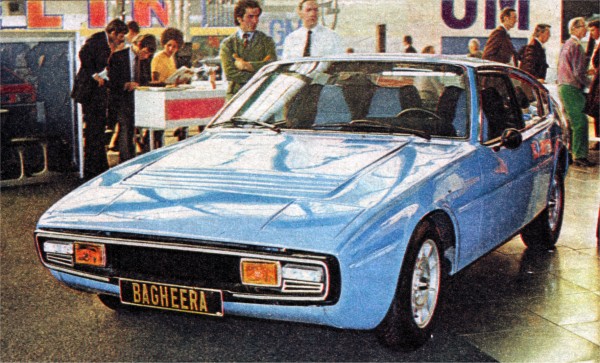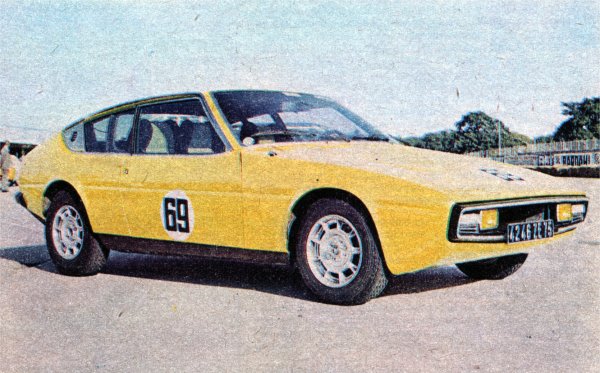Description
The Matra-Simca Bagheera, introduced in 1973, was one of the most imaginative and unconventional European sports cars of the 1970s. Conceived as a replacement for the Matra 530, the Bagheera embodied Matra’s core philosophy: lightweight construction, mid-engine balance, bold styling and everyday practicality — all at an accessible price. Developed in partnership with Simca, it became one of Matra’s most successful road cars and a defining model in the company’s automotive history.
Unveiled at the height of the fuel-conscious 1970s, the Bagheera was designed to offer sporting character without the cost and complexity associated with traditional GT cars. Its sleek, wedge-influenced bodywork was shaped around a mid-engined layout and a remarkably practical interior that seated three people abreast — a configuration unique among production sports cars. This unusual seating arrangement, combined with the car’s affordability and futuristic styling, helped the Bagheera stand out immediately.
The Bagheera was built on a pressed-steel monocoque chassis onto which Matra bonded fibreglass-reinforced polyester body panels. This construction method kept weight low, resisted corrosion better than steel and allowed for flowing, aerodynamically clean bodywork without expensive tooling. The long, sloping nose, smooth flanks and sharply cut tail gave the car a purposeful stance, clearly influenced by contemporary aerodynamic research. Pop-up headlights sat flush with the body when not in use, further reducing drag and contributing to the car’s distinctive, modernist profile.
The mid-engine layout placed the drivetrain transversely behind the cabin. Early Bagheeras used Simca’s 1,294 cc four-cylinder engine producing around 84 horsepower, while later versions adopted the larger 1.4-litre engine with slightly more output. Though modest in displacement, the engines worked well thanks to the car’s lightness: kerb weight hovered around 900 kg, giving the Bagheera sprightly performance. Top speeds between 170–185 km/h (105–115 mph) were typical depending on the engine, and the cars felt lively in real-world driving thanks to rev-happy motors and short gearing.
Suspension was fully independent. At the front, coil springs and wishbones delivered sharp turn-in and good grip, while the rear used trailing arms with coil-spring units to maintain stability and traction. This setup, combined with the mid-engine weight distribution, made the Bagheera agile, predictable and fun to drive. It was not a high-horsepower sports car, but its balance and lightness meant it could maintain momentum and carry impressive speed through corners. Rack-and-pinion steering provided good feedback, and braking was handled by front discs and rear drums — sufficient for the car’s performance level.
Inside, the Bagheera’s most famous feature took centre stage: the three-across seating. The driver sat slightly ahead of the outer passengers, giving all occupants good forward visibility while maintaining a narrow cabin footprint. This layout allowed the Bagheera to function as a family sports car — an unusual proposition in the 1970s and a hallmark of Matra’s inventive approach. The dashboard was clean, modern and slightly angled toward the driver, with a full set of instruments and intuitive switchgear. The boot, located at the rear, was a practical size thanks to the compact transverse drivetrain.
On the road, the Bagheera won praise for its handling balance, lightness and stability. The car felt composed at motorway speeds and engaging on twisting country roads, offering a secure, confidence-inspiring driving experience. It was comfortable enough for long distances, yet nimble and responsive in town. Journalists of the time highlighted its excellent visibility, ergonomic interior and futuristic ambience.
One area where the Bagheera fell short was body durability: although the fibreglass panels resisted corrosion, the steel monocoque beneath was prone to rust if not properly protected. This issue has made surviving early cars rarer today than production numbers would suggest.
The Bagheera was produced from 1973 to 1980 across three major series, with incremental improvements in styling, trim and mechanical details. Nearly 48,000 examples were built — a remarkable figure for a niche mid-engined sports car — making it Matra’s most commercially successful model before the later Rancho and Murena.
Today, the Matra-Simca Bagheera is remembered as one of the most original sports cars of its time. Its combination of inventive packaging, distinctive styling, mid-engine dynamics and accessibility created a car unlike anything else on the market. It remains a symbol of Matra’s unique design ethos: imaginative, practical, aerodynamic and delightfully unconventional.

